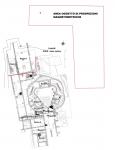Summary (English)
The excavation of the villa, halted in 2012, reopened in 2015 following the acquisition of the land by the town council of San Gimignano. As the acquisition was only formalised in January 2015, there was no time to request an excavation permit from the Archaeological Superintendency of Tuscany. Therefore, the only actions undertaken were the clearing of vegetation, the restoration of the state of preservation of the walls and a campaign of geomagnetic surveys, the latter carried out by Luca Passalacqua and Gabriella Carpentiero from the University of Siena.
1. Following the partial removal of earth supporting an irrigation pipe, crossing the northern sector of the villa from north to south and east to west, the spatial unity of the area was restored and prepared for future excavation.
2. A 1 m2 trench was opened to check the state of preservation of the cement floor in the so called triapsidal hall. No new problems were recorded.
3. Lastly, a test was undertaken for a geomagnetic survey of the outside the north and north-eastern excavated sector of the villa. The aim was to check the efficiency of this method and highlight the presence of any archaeological anomalies. A Gradiometer Fluxgate FM256 (Geoscan Research Ltd.) was used that made it possible to carry out the test in a short time and using non-invasive techniques.
Several linear anomalies were documented in the investigated area; however, they were close to two large areas of modern disturbance that would compromise continuation of the investigations. Furthermore, the geological context would have rendered the data less legible. Therefore, the test result was negative.
- Marco Cavalieri- Université catholique de Louvain, Belgio
Director
- Marco Cavalieri - Universitè Catholique de Louvain, Faculté de Philosophie et Lettres, Département d’Archéologie et d’Histoire de l’Art
Team
- Agnese Lodi
- Alessandro Neri- Università degli Studi di Firenze
- Angela Sardini- Scuola di Specializzazione in Beni Archeologici – Sapienza Università di Roma
- Chiara Leporati-Fondazione Dià Cultura
- François-Dominique Deltenre- École française d’Athènes
- Gabriele Mainardi Valcarenghi
- Gloriana Pace- Università degli Studi di Pisa
- Jean-Christophe Caestecker
- Lucia Orlandi- Università di Bologna
- Sara Lenzi- Università degli Studi di Firenze
- Charles Bossu- Academia Belgica - Roma
- Alberto Garzonio- Università degli Studi di Firenze
- Anthony Peeters - UCLouvain
- Brieuc Guillaume
- Alessandro Novellini
Research Body
- Université catholique de Louvain
Funding Body
- Université catholique de Louvain






![Download [PDF]](/excavation/skins/fasti/images/results/download_sml.png)